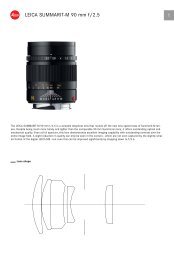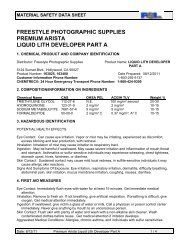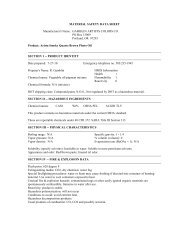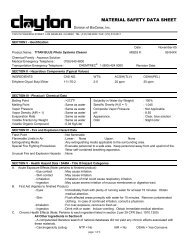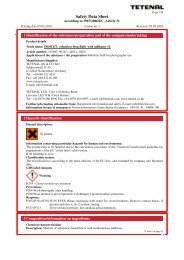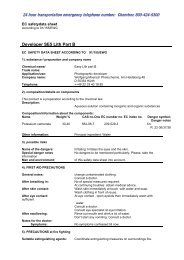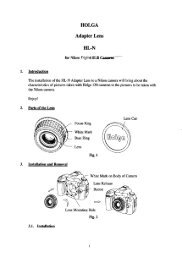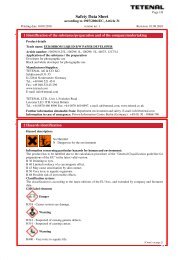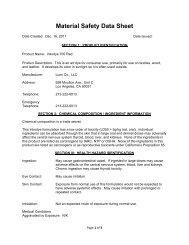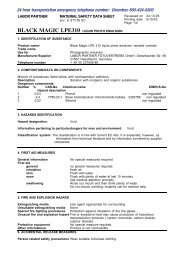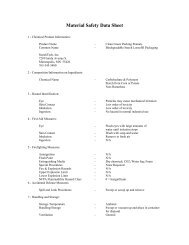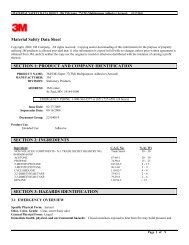PAN F PLUS TECH INFO - the ILFORD PHOTO Website
PAN F PLUS TECH INFO - the ILFORD PHOTO Website
PAN F PLUS TECH INFO - the ILFORD PHOTO Website
You also want an ePaper? Increase the reach of your titles
YUMPU automatically turns print PDFs into web optimized ePapers that Google loves.
<strong>PAN</strong> F Plus<br />
PROCESSING<br />
<strong>PAN</strong> F Plus can be processed in all types of<br />
processing equipment including spiral tanks, rotary<br />
processors, dishes/trays, deep tanks and<br />
automatic processors. Standard capacity figures<br />
and replenishment rates can be maintained. <strong>PAN</strong> F<br />
Plus is very robust in processing and will tolerate<br />
less than ideal processing conditions. Also, it will<br />
not contaminate <strong>the</strong> processing chemicals.<br />
Safelight recommendations<br />
Handle <strong>PAN</strong> F Plus film in total darkness. For very<br />
brief inspections during processing, use <strong>the</strong> <strong>ILFORD</strong><br />
908 (very dark green) safelight filter, with a 15W<br />
bulb, fitted in a darkroom lamp (such as <strong>the</strong><br />
<strong>ILFORD</strong> DL10 or DL20). Do not allow direct<br />
lighting from <strong>the</strong> safelight to fall on <strong>the</strong> film.<br />
Agitation<br />
Intermittent agitation is recommended for use in<br />
spiral tanks and deep tanks. With spiral tanks,<br />
invert <strong>the</strong> tank four times during <strong>the</strong> first 10<br />
seconds, <strong>the</strong>n invert <strong>the</strong> tank four times again<br />
during <strong>the</strong> first 10 seconds of each fur<strong>the</strong>r minute.<br />
O<strong>the</strong>rwise, follow <strong>the</strong> recommendations given by<br />
<strong>the</strong> processing equipment manufacturer.<br />
Stop, fix, wash and rinse<br />
For best results it is recommended that all process<br />
solutions are kept at <strong>the</strong> same temperature or at<br />
least within 5ºC (9ºF) of <strong>the</strong> developer<br />
temperature.<br />
Stop Bath<br />
After development <strong>the</strong> film can be rinsed in water<br />
but we recommend that an acid stop bath is used<br />
such as <strong>ILFORD</strong> ILFOSTOP (with indicator dye) or<br />
ILFOSTOP PRO (without indicator dye). ILFOSTOP<br />
PRO is recommended for all machine processing<br />
applications. When tanks or dishes (trays) of<br />
process solutions are in use a stop bath<br />
immediately stops development and reduces carry<br />
over of excess developer into <strong>the</strong> fixer bath. This<br />
helps to maintain <strong>the</strong> activity and prolong <strong>the</strong> life<br />
of <strong>the</strong> fixer solution.<br />
<strong>ILFORD</strong> Stop ILFOSTOP ILFOSTOP PRO<br />
Bath<br />
Dilution 1+19 1+19<br />
Temperature 18–24ºC 18–24ºC<br />
range (64–75ºF) (64–75ºF)<br />
Time (seconds)<br />
at 20ºC (68ºF)<br />
Page 5 of 6<br />
10 10<br />
Capacity<br />
films/litre 15x(135–36) 22x(135–36)<br />
(unreplenished)<br />
The process time given is <strong>the</strong> minimum required, if<br />
necessary a longer time may be used and should<br />
not cause any process problems provided it is not<br />
excessive.<br />
Fix<br />
The recommended fixers are <strong>ILFORD</strong> RAPID FIXER<br />
and <strong>ILFORD</strong> HYPAM liquid fixers and <strong>ILFORD</strong><br />
ILFOFIX II powder fixer,all are non-hardening<br />
fixers.<br />
<strong>ILFORD</strong> Fixer <strong>ILFORD</strong> HYPAM & <strong>ILFORD</strong><br />
<strong>ILFORD</strong> RAPID FIXER ILFOFIX II<br />
Dilution 1+4 stock<br />
Temperature 18–24ºC 18–24ºC<br />
range (64–75ºF) (64–75ºF)<br />
Time (mins)<br />
at 20ºC (68ºF)<br />
2–5 4–8<br />
Capacity<br />
films/litre 24x(135–36) 24x(135–36)<br />
(unreplenished)<br />
WASH<br />
When a non-hardening fixer has been used wash<br />
<strong>the</strong> films in running water for 5–10 minutes at a<br />
temperature within 5ºC (9ºF) of <strong>the</strong> process<br />
temperature.<br />
For spiral tank use, when a non-hardening fixer<br />
has been used, <strong>the</strong> following method of washing is<br />
recommended. This method of washing is faster,<br />
uses less water yet still gives negatives suitable for<br />
long term storage.<br />
After fixing, fill <strong>the</strong> spiral tank with water at <strong>the</strong><br />
same temperature, +/– 5ºC (9ºF), as <strong>the</strong><br />
processing solutions and invert it five times. Drain<br />
<strong>the</strong> water away and refill. Invert <strong>the</strong> tank ten times.<br />
Once more drain <strong>the</strong> water away and refill.<br />
Finally, invert <strong>the</strong> tank twenty times and drain <strong>the</strong><br />
water away.<br />
Rinse<br />
For a final rinse use <strong>ILFORD</strong> ILFOTOL wetting<br />
agent added to water, it helps <strong>the</strong> film to dry<br />
rapidly and evenly. Start by using 5ml per litre of<br />
rinse water (1+200), however <strong>the</strong> amount of<br />
ILFOTOL used may need some adjustment<br />
depending on <strong>the</strong> local water quality and drying<br />
method. Too little or too much wetting agent can<br />
lead to uneven drying. Remove excess rinse<br />
solution from <strong>the</strong> film before drying.




